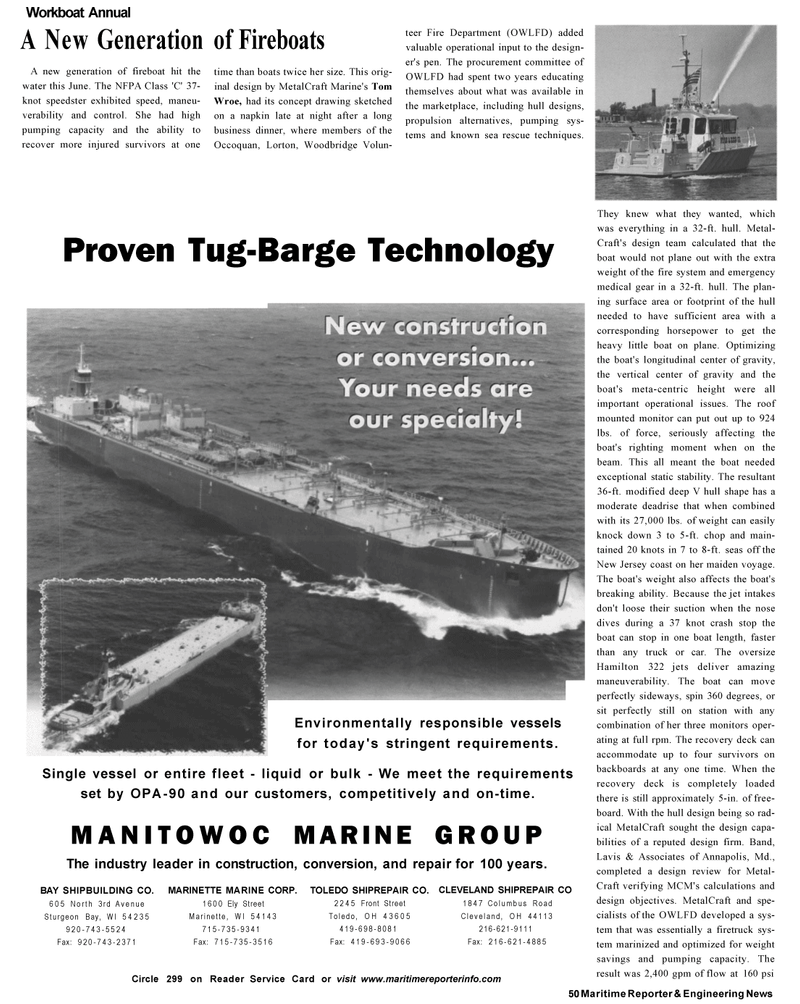
Page 48: of Maritime Reporter Magazine (November 2002)
Read this page in Pdf, Flash or Html5 edition of November 2002 Maritime Reporter Magazine
Workboat Annual
A New Generation of Fireboats
A new generation of fireboat hit the water this June. The NFPA Class 'C' 37- knot speedster exhibited speed, maneu- verability and control. She had high pumping capacity and the ability to recover more injured survivors at one time than boats twice her size. This orig- inal design by MetalCraft Marine's Tom
Wroe, had its concept drawing sketched on a napkin late at night after a long business dinner, where members of the
Occoquan, Lorton, Woodbridge Volun- teer Fire Department (OWLFD) added valuable operational input to the design- er's pen. The procurement committee of
OWLFD had spent two years educating themselves about what was available in the marketplace, including hull designs, propulsion alternatives, pumping sys- tems and known sea rescue techniques.
Proven Tug-Barge Technology
Environmentally responsible vessels for today's stringent requirements.
Single vessel or entire fleet - liquid or bulk - We meet the requirements set by OPA-90 and our customers, competitively and on-time.
MANITOWOC MARINE GROUP
The industry leader in construction, conversion, and repair for 100 years.
BAY SHIPBUILDING CO. 605 North 3rd Avenue
Sturgeon Bay, Wl 54235 920-743-5524
Fax: 920-743-2371
MARINETTE MARINE CORP. 1600 Ely Street
Marinette, Wl 54143 715-735-9341
Fax: 715-735-3516
TOLEDO SHIPREPAIR CO. 2245 Front Street
Toledo, OH 43605 419-698-8081
Fax: 419-693-9066
CLEVELAND SHIPREPAIR CO 1847 Columbus Road
Cleveland, OH 44113 216-621-9111
Fax: 216-621-4885
Circle 299 on Reader Service Card or visit www.maritimereporterinfo.com
They knew what they wanted, which was everything in a 32-ft. hull. Metal-
Craft's design team calculated that the boat would not plane out with the extra weight of the fire system and emergency medical gear in a 32-ft. hull. The plan- ing surface area or footprint of the hull needed to have sufficient area with a corresponding horsepower to get the heavy little boat on plane. Optimizing the boat's longitudinal center of gravity, the vertical center of gravity and the boat's meta-centric height were all important operational issues. The roof mounted monitor can put out up to 924 lbs. of force, seriously affecting the boat's righting moment when on the beam. This all meant the boat needed exceptional static stability. The resultant 36-ft. modified deep V hull shape has a moderate deadrise that when combined with its 27,000 lbs. of weight can easily knock down 3 to 5-ft. chop and main- tained 20 knots in 7 to 8-ft. seas off the
New Jersey coast on her maiden voyage.
The boat's weight also affects the boat's breaking ability. Because the jet intakes don't loose their suction when the nose dives during a 37 knot crash stop the boat can stop in one boat length, faster than any truck or car. The oversize
Hamilton 322 jets deliver amazing maneuverability. The boat can move perfectly sideways, spin 360 degrees, or sit perfectly still on station with any combination of her three monitors oper- ating at full rpm. The recovery deck can accommodate up to four survivors on backboards at any one time. When the recovery deck is completely loaded there is still approximately 5-in. of free- board. With the hull design being so rad- ical MetalCraft sought the design capa- bilities of a reputed design firm. Band,
Lavis & Associates of Annapolis, Md., completed a design review for Metal-
Craft verifying MCM's calculations and design objectives. MetalCraft and spe- cialists of the OWLFD developed a sys- tem that was essentially a firetruck sys- tem marinized and optimized for weight savings and pumping capacity. The result was 2,400 gpm of flow at 160 psi 50 Maritime Reporter & Engineering News

 47
47

 49
49
